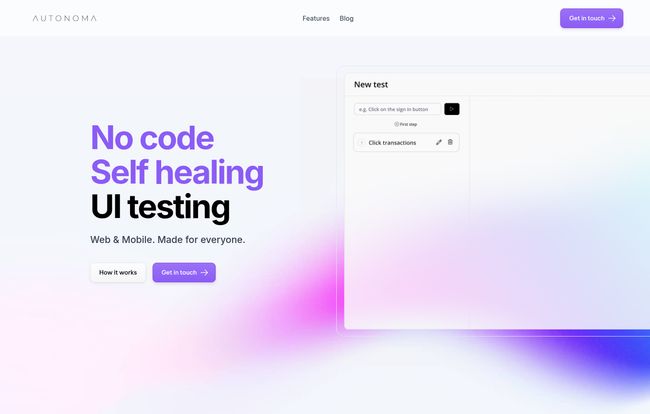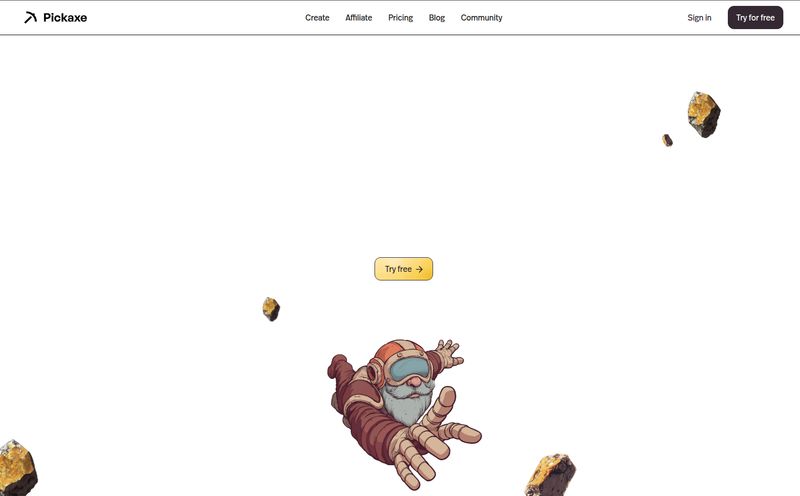You and me. About UI testing. For years, it’s been the necessary evil of the software development world, hasn't it? That final, creaky gate you have to shove open before you can ship your code. We've all been there, burning the midnight oil because a simple CSS tweak to a button caused a catastrophic failure across the entire test suite. Your tests, which you spent weeks building, are now as fragile as a glass castle in an earthquake.
We've tried to tame this beast with tools like Selenium and Cypress. And don't get me wrong, they're powerful. But they require dedicated expertise and constant, painstaking maintainance. Every time the front-end team gets creative, the QA team groans, knowing they'll be hunting down broken selectors for the next two days.
So, when a tool comes along with a promise that sounds almost too good to be true—“No-code, self-healing UI testing”—my inner skeptic and my hopeful optimist get into a fistfight. The tool in question is Autonoma AI, and I decided to see if it’s just another buzzword-laden dream or a genuine solution to a problem that has plagued us for decades.
So, What's the Big Deal with Autonoma AI?
At its core, Autonoma AI pitches a very seductive idea. It’s an AI-driven platform that lets you build end-to-end tests for your web and mobile apps without writing a single line of code. Think about that for a second. No more wrestling with WebDriver syntax or trying to find that dynamically generated ID.
The process is meant to be simple: the AI observes user flows and automatically generates the tests. This isn't just for QA engineers, either. The idea is that anyone, from product managers to junior developers, can create reliable tests. It’s a bold claim, and one that could seriously change how teams approach quality assurance.

Visit Autonoma AI
But the real magic, the part that made me raise an eyebrow in genuine curiosity, is the “self-healing” part.
The So-Called Magic of “Self-Healing” Tests
This is Autonoma's killer feature. Traditional automated tests are brittle. They rely on specific paths, IDs, or element structures. If a developer changes a `
Autonoma AI claims its tests are different. Because the AI understands the application at a more contextual level—not just “click the element with ID ‘submit-btn-final-v2’”—it can adapt when the UI changes. That button you moved from the left to the right side of the page? Or renamed from “Submit” to “Let's Go!”? The AI is supposed to figure it out and update the test on the fly, without manual intervention. It's like having a psychic QA engineer who anticipates changes before they even break the build.
If this works as advertised, the amount of time saved on test maintenance would be… staggering. We’re talking about freeing up entire days, or even weeks, of developer and QA time. Time that could be spent building new features instead of fixing old tests.
It’s Not Just a Tester, It’s a Code Archaeologist
Here’s something I didn’t expect. Buried in its feature list is a claim that Autonoma can help you understand legacy code. You know, that horrifying, tangled mess of a project that was built ten years ago by a developer who has long since vanished. The one everyone calls “spaghetti code.”
Autonoma says it can crawl through that digital haunted house and generate a wiki. Not just any wiki, but one complete with API documentation, feature descriptions, and implementation details. It essentially reverse-engineers the application's functionality into human-readable docs. As someone who has been dropped into a legacy project with zero documentation, the value of this cannot be overstated. It’s the difference between having a map and being lost in a forest at night.
Some Real-Talk on Using Autonoma
Okay, the promises are huge. But what's the reality? Based on what I've gathered, the upsides are pretty clear. The main advantage is lowering the barrier to entry for test automation and slashing the insane overhead of maintenance. It supports both web and mobile, which is a big checkmark in today’s world. The potential to democratize testing is real.
But it's not all sunshine and rainbows. Now for a little story. I was poking around their site, getting pretty excited about the potential, and I naturally went looking for the pricing page. And what did I find?
A 404 Page Not Found error.
I had to laugh. A UI testing company with a broken link on their site. It’s a bit ironic, isn't it? But it also tells a story. This feels like a product that's still evolving, probably a startup that's moving fast (and maybe breaking a few things). It also points to one of the cons: the pricing is not readily available. You can't just check a few tiers and sign up.
This also brings up another point: how effective is it on really complex UIs? You know, the ones with deeply nested components and all sorts of asynchronous state changes. While AI is smart, I suspect there are edge cases where it might still get confused, which is a fair limitation for any tool in this space.
So, How Much Does This Magic Cost?
As my little 404 adventure suggests, Autonoma AI isn't broadcasting its pricing. This is pretty typical for enterprise-focused B2B SaaS. They want you to book a demo, talk to a sales rep, and get a custom quote. I’m personally not a huge fan of this model—I like transparency—but I understand why they do it. It helps them qualify leads and tailor the offering.
So the short answer is: you have to contact them to find out. Prepare to have a conversation about your team size, your needs, and your budget.
Who is This Tool Really For?
After digging in, I have a pretty good idea of who would get the most out of Autonoma AI.
- Startups and Lean Teams: If you don’t have the budget or headcount for a full-time QA automation specialist, this could be a game-changer. It gives you the power of a robust testing suite without the specialized skillset.
- Companies with Gnarly Legacy Systems: If you have a critical but poorly-documented application, the wiki-generation feature alone could justify the cost. Seriously. It’s a tool for taming old beasts.
- Fast-Moving Agile Teams: When you're shipping updates weekly or even daily, you can’t afford to be bogged down by test maintenance. A self-healing system is built for the chaos of modern CI/CD pipelines.
Who might want to hold off? If you already have a deeply integrated and smoothly running automation framework with a team dedicated to it, ripping it out for a new tool might not make sense. But for everyone else struggling to keep up, this is definitely worth investigating.
My Final Verdict
Autonoma AI is tackling one of the most persistent, frustrating problems in software development. The vision of no-code, self-healing tests is more than just a nice-to-have; it's a fundamental shift in how we think about quality. While the lack of public pricing and the occasional broken link suggest it's still a growing platform, the core ideas are incredibly powerful.
Is it a magic wand that will instantly solve all your testing problems? Probably not. But it is a seriously compelling tool that represents the future of QA. A future with less frustration, less repetitive work, and more time spent creating things people love. And I am absolutely here for that future.
Frequently Asked Questions about Autonoma AI
- What is Autonoma AI in simple terms?
- Autonoma AI is a tool that uses artificial intelligence to automatically create and maintain UI tests for web and mobile applications. You don't need to write any code; the AI learns from how you use your app and builds the tests for you. Its key feature is that the tests can “heal” themselves when you make changes to your app's design.
- Do I need to be a programmer to use Autonoma?
- No. The entire platform is built around a “no-code” philosophy. This means product managers, manual testers, and designers can create sophisticated tests without needing to know a programming language.
- How does the 'self-healing' actually work?
- Instead of relying on rigid code selectors (like a specific ID or class name), the AI understands elements by a combination of attributes and their context within the page. If a button's text, color, or position changes, the AI is smart enough to recognize it's likely the same button and adapts the test, preventing a false failure.
- What platforms does Autonoma AI support?
- It is designed to work for both modern web applications and native mobile apps (iOS and Android), providing a unified testing solution for teams that work across platforms.
- Can Autonoma AI really document my old, messy code?
- Yes, this is one of its standout features. By analyzing a codebase, it can generate a functional wiki that explains what different parts of the application do, including API endpoints and feature flows. It’s designed to bring clarity to complex or poorly documented projects.
- Is Autonoma AI a free tool?
- No, it's a commercial product. The company does not list its prices publicly, so you will need to contact their sales team for a demo and a custom quote based on your team's needs.
Reference and Sources
- Autonoma AI Official Website
- Martin Fowler on Test Flakiness - A great read on the problems that tools like Autonoma aim to solve.


